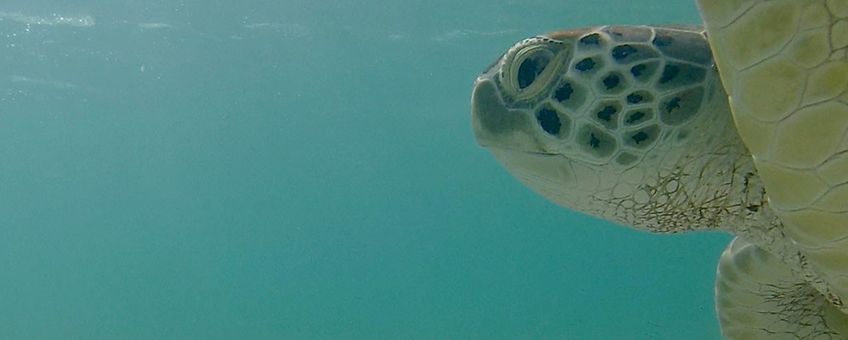
Green sea turtle digging its own watery grave due to invasion of non-native seagrass
Wageningen Marine ResearchSince the opening of the Suez Canal in 1892, the seagrass Halophila stipulacea, once isolated in the Red Sea, began making its way into the Mediterranean. That did not cause any problems for existing populations of seagrass in those areas. However, the exotic seagrass reached the eastern Caribbean by ship in 2002, where it turned out to be dominant over the original seagrass, the native Thalassia testudinum. This has allowed the non-native species to form extensive meadows on the sea floor.
The green sea turtle (Chelonia mydas) swims in these same tropical waters. For millions of years, it has been gracefully grazing in the fields of the native seagrass species. This large grazer primarily forages in the deeper areas of the seagrass meadows. However, this began to change in 2002. That was the year that this exotic seagrass invader made its entrance from the Red Sea. This foreign seagrass spread quickly across the eastern Caribbean and formed thick meadows in the foraging areas of green sea turtles.
Understanding the turtle seagrass interaction
In 2010, the new species found its way to Lac Bay on the island of Bonaire, in the Dutch Caribbean, where a research team with Marjolijn Christianen, Lisa Becking of Wageningen University & Research and Per Palsbøll from the University of Groningen designed a study funded by the Netherlands Organisation for Scientific Research (NWO) and the Dutch Ministry of Economic Affairs (now LNV). Their goal was to investigate the role of sea turtles in the distribution of this exotic seagrass species. The team, further strengthened by colleagues of the University of Amsterdam, Sea Turtle Conservation Bonaire, STINAPA Bonaire and Wageningen Marine Research, wants to research how these large grazers influence the expansion of exotic plant species in aquatic systems.
The team conducts field observations, conducts experiments in underwater cages, and gathers satellite images of grazing areas from the last 40 years in order to compare the size and boundaries of the seagrass fields with their current condition. In a time lapse of satellite images, they are able to see how the underwater terrain on which the sea turtles graze has been slowly increasing by 72 per cent (up to 65 hectares). The sharp boundary between grazed and ungrazed seagrass fields is shifting towards shallower areas with native seagrass species which previously (1970-2010), had not been grazed.
Food preferences of sea turtles
Marjolijn Christianen and her colleagues also outfitted the green sea turtles with GPS trackers, so that they could follow their eating path underwater. These observations confirmed the idea that the turtles are largely dedicated to the newly grazed areas, which confirms that the change to the underwater landscape was driven by the turtles. They also conducted experiments involving the food preferences of the turtles, because, if the invasive species were equally appealing as their established food source, the invasion might have fewer consequences. However, laboratory measurements indicated that the exotic seagrass is 2.5 times less nutritious for the sea turtle, not to mention that the green sea turtle turns its nose up at the new food. In food preference experiments (nicknamed cafeteria experiments by the researchers), they only ate the new seagrass species one out of ten times, compared to nine out of ten for their traditional food source.
However, what was even more problematic for the researchers is that they observed the exotic seagrass spreading more quickly in grazed areas in comparison to ungrazed areas. Ultimately, in the six years between 2011 and 2017, Halophila stipulacea underwent an expansion of six to twenty per cent of the permanent monitoring locations. During the same period, coverage with the native seagrass Thalassia testudinum dropped by 33 per cent.
“These results provide the first proof of the large-scale replacement of the native seagrass by the rapidly proliferating Halophila stipulacea in the Caribbean as well as a mechanistic explanation for the invasiveness,” says Marjolijn Christianen. “This shows how large herbivores play a significant but previously unrecognised role in the expansion of exotic plant species in aquatic ecosystems.”

Water purification helps the sea turtle
Is there nothing that can be done? According to the researchers, it would beneficial for sea regions if they were less polluted by sewage or dredging activity, as this decreases the vitality of the old seagrass fields. “We are seeing that sea turtles are facilitating the expansion of the invasive seagrass through their grazing behaviour. If you want to protect these charismatic grazers, stress factors have to be reduced throughout the ecosystem. Therefore, water purification and removing factors that generate murky water in seagrass fields will help. For the dry Caribbean islands, this would partially be addressed by counteracting overgrazing by goats on the islands, as they eat everything until the ground is bare which encourages erosion.
Text: Wageningen Marine Research
Photos: Marjolijn Christianen
